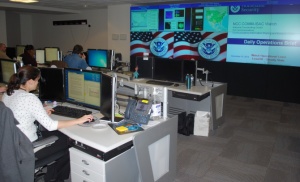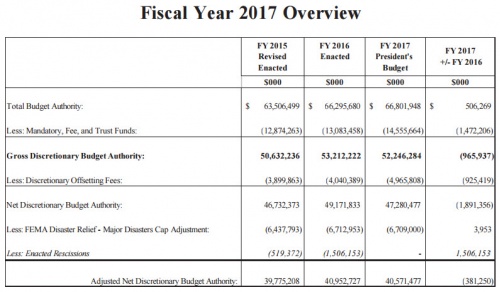Situational Awareness
Contents
- 1 Situational Awareness
- 2 What is Situational Awareness
- 3 What Does Situational Awareness Do?
- 4 Staffing and Budget
- 4.1 ANALYSIS AND OPERATIONS=
- 4.2 FY2016 Highlights
- 4.3 NATIONAL PROTECTION AND PROGRAMS DIRECTORATE
- 4.4 King Air (KA)-350CER Multi-Role Enforcement Aircraft (MEA) ........ $44.4M (0 FTE)
- 4.5 Border Security Deployment Program (BSDP)......................................... $11.1M (0 FTE)
- 4.6 FAA NextGen Compliance Compliance ...............................................................$1.6M (0 FTE)
Situational Awareness
The following sets out to provide a high-level overview of situational awareness (SA). This page will describe both in general context, as well as examples applied to the Department of Homeland Security (DHS):
- What is "situational awareness"?
- What does it do?
- How many people are in it?
- What is its budget?
- Who leads it?
- Where was it before it was moved to DHS?
- Are there any controversies or interesting things you identified? This could be
used to elicit contributions from other students
What is Situational Awareness
Situational awareness refers to the collection and analysis of environmental elements and events, to understand those critical elements of information to maintain a mission or operations. Situational awareness is commonly bridged to incident management, in that a key element of understanding those critical elements of information is to identify potential threats that may disrupt that mission or operations.
Situational awareness has broad application across different types of organizations. In government, situational awareness is utilized in the Department of Homeland Security, in all branches of military command and control, air traffic control, police, fire & emergency services. In business settings, situational awareness is applied in areas such as telecom network operating centers, and corporate security management. On an individual level, we all leverage situational awareness in common day activities such as driving an automobile, or being aware of our personal security in our setting.
What Does Situational Awareness Do?
Staffing and Budget
While there is no single DHS line item for staff and budget identified specifically for situational awareness, many elements of the DHS budget reference expenses to support situational awareness.
ANALYSIS AND OPERATIONS=
- Budget Request: $265,719,000
- Staffing (FTE): 801
- Senior Leadership:
- Francis X. Taylor, Under Secretary for Intelligence and Analysis
- Richard M. Chávez, Director, Office of Operations Coordination
- Established: 2006
- Major Divisions: Office of Intelligence and Analysis; Office of Operations Coordination
Description
The Analysis and Operations appropriation provides resources to support the Office of Intelligence and Analysis (I&A) and the Office of Operations Coordination (OPS). This appropriation includes both National Intelligence Program (NIP) and non- NIP funds.
While these two Components are distinct in their missions, they work closely together and collaborate with other DHS Components and federal agencies, as well as state, local, tribal, territorial (SLTT), foreign, and private-sector partners. Together these Components strive to improve intelligence analysis, information sharing, incident management support, and situational awareness.
FY2016 Highlights
Develop Situational Awareness & Infrastructure Analysis ……………$10.4M (19 FTE)
Funds enhancements in cybersecurity situational awareness and information sharing. This includes Integrated Analysis Cell, STIX/TAXII, Media & Collective Analysis, National Cybersecurity Technical Services teams, and ensures that standards are integrated into the architecture for collected data, enabling NPPD to better integrate cyber and physical data.
NATIONAL PROTECTION AND PROGRAMS DIRECTORATE
Budget Requested: $3,102,862,000 Employees (FTEs): 3,527
Description
The National Protection and Programs Directorate (NPPD) leads national efforts to strengthen the security and resilience of the Nation’s critical infrastructure against terrorist attacks, cyber events, natural disasters, other large-scale incidents, and during national security special events. Secure and resilient infrastructure is essential for national security, economic vitality, and public health and safety. NPPD collaborates with the owners and operators of infrastructure to maintain near real-time situational awareness of both physical and cyber events and share information that may disrupt critical infrastructure. Through partnerships with Federal, State, local, tribal, territorial, international, and private-sector entities, NPPD identifies and enables mitigation and risk reduction to infrastructure and builds capacity to secure the Nation.
King Air (KA)-350CER Multi-Role Enforcement Aircraft (MEA) ........ $44.4M (0 FTE)
The budget provides an increase of $44.4 million for two KA-350CER MEAs. The MEA is a multi-role enforcement aircraft with a multi-mode radar for use over water and land, and for air-to-air situational awareness. It is the most capable new, twin-engine aircraft that CBP has purchased and is a critical investment to support Border Patrol agents and improve airto-ground surveillance capabilities.
Border Security Deployment Program (BSDP)......................................... $11.1M (0 FTE)
The budget provides an increase of $11.1 million for BDSP. BSDP provides CBP with a comprehensive and expanded secure operational environment through an integrated surveillance and intrusion detection system that delivers critical security, motion detection, remote monitoring, and situational awareness for all LPOEs. BSDP is a mission critical tool for the LPOEs where CBP officers and agents use security, surveillance, and audio systems on a 24x7 basis. BSDP improves the safety and security of CBP officers, the traveling public, and government facilities. BSDP also promotes officer integrity, and adjudicates judicial investigations through court admissible video and audio recordings. BSDP, as a force multiplier, allows CBP officers and agents to focus their attention on the efficient flow of people and goods at the border. BSDP situational awareness at LPOEs is also used to monitor the overall operations at LPOEs and make real-time efficiency and risk adjustments as needed.
FAA NextGen Compliance Compliance ...............................................................$1.6M (0 FTE)
The budget provides $1.6 million to support the phased purchase and installation of Automatic Dependent Surveillance-Broadcast (ADS-B) transponders and cockpit displays in all OAM aircraft. The Federal Aviation Administration (FAA) intends to mandate increased ADSB-Out pilot and controller situational awareness in the satellite based NextGen airspace system. The use of ADS–B for aircraft surveillance by FAA and Department of Defense (DOD) air traffic controllers will safely and efficiently accommodate aircraft operations and the expected increase in demand for air transportation.

